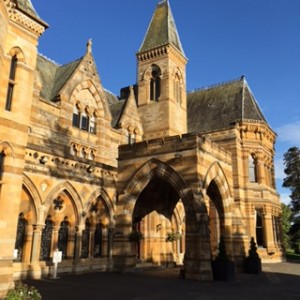 I was hardly dressed for afternoon tea in a smart country house hotel. We had been on the road since 10am and I had dressed for comfort, not style, en route to the Midlands, to deliver our younger son to university. However, we were passing close by, we had skipped lunch, and afternoon tea in salubrious surroundings sounded more than a little tempting.
I was hardly dressed for afternoon tea in a smart country house hotel. We had been on the road since 10am and I had dressed for comfort, not style, en route to the Midlands, to deliver our younger son to university. However, we were passing close by, we had skipped lunch, and afternoon tea in salubrious surroundings sounded more than a little tempting.
Ettington Park is a sumptuous neo-Gothic country house only six miles from Stratford upon Avon. Once the seat of the Anglo-Irish Shirley family, it has also masqueraded as a nursing home and a prisoner of war camp during WWII. Today it is part of the Hand Picked Hotel chain. It has been altered and amended many times over the centuries, but its current appearance owes much to the Gothic Revival, an architectural movement also known as Neo Gothic that began in England in the late 1740s and became enormously popular throughout the nineteenth century. Adopting features from the original Gothic style, the Neo-Gothic style loves ornamentation, particularly around the windows, gables and roof line. The house is set in 40 acres of lush Warwickshire countryside on the River Stour, all that is left of the original 1,700 acre estate. According to a recent history of ‘The Buildings of England,’ (Pickford & Pevsner), it is considered “the most important and impressive High Victorian house in the county.” It is also, apparently, the most haunted.
As we drove up the sweeping, tree-lined driveway, Ettington Park, with its grey/blue and honey coloured façade, arched windows and turrets, appeared around the bend like a small, fairy tale castle hidden in the woods.
Our son knew the manager, so despite the lack of tiara and twin sets, we were greeted like family and ushered into the glorious Great Drawing Room with its ornate rococo ceiling and elegantly arched windows overlooking sweeping lawns.
One of the staff members, Daimon, came over to offer us a short but enthusiastic tour before he clocked off, and we followed him willingly up to the gallery, down to the library and dining room and out into the garden for a whirlwind tour of the hotel’s highlights. Above the dining room window is a balcony he claims was the inspiration for Shakespeare’s “Romeo and Juliet.” And the carving of a frog on an outside wall commemorates the discovery of the Toad of Ettington, that appeared to have lived in a hidden wall cavity for almost 120 years. We also learned about the various ghosts believed to inhabit the house, amongst them a governess, a gamekeeper, a servant girl and two children who drowned in the river at the turn of the nineteenth century.
While Daimon knows a lot about the history of the house and its many ghosts, he is also an expert on the origins of old English sayings, and regaled us with many funny tales relating to the cat-of-nine-tales, after which we wandered back to the drawing room, where our afternoon was waiting: a three-tiered cake stand brimming with sandwiches and scones, brownies and macaroons. With several different teas to choose from, we had opted for the Midsummer afternoon tea.
As always, I dived amongst the sandwiches with delight: delicately flavoured cucumber and cream cheese fingers with that satisfying crunch; salmon and cream cheese bagels, a hefty coronation chicken wrap, and a roast beef and  beetroot sandwich in need of salt. The scones were perfect – soft on the inside, with a crusty surface, accompanied by an espresso cup of strawberry jam and real clotted cream. The top layer was piled high with sweet things. There were rich moist chocolate brownies and extraordinary pink macaroons with a creamy, cloying peanut butter filling (we were not altogether convinced about the wisdom of that combination.) Then an odd layered cake of strawberry mousse and chocolate cake topped with jelly. Finally a lemon tart, the filling a satisfying blend of creaminess and zestiness, but the pastry a tad doughy.
beetroot sandwich in need of salt. The scones were perfect – soft on the inside, with a crusty surface, accompanied by an espresso cup of strawberry jam and real clotted cream. The top layer was piled high with sweet things. There were rich moist chocolate brownies and extraordinary pink macaroons with a creamy, cloying peanut butter filling (we were not altogether convinced about the wisdom of that combination.) Then an odd layered cake of strawberry mousse and chocolate cake topped with jelly. Finally a lemon tart, the filling a satisfying blend of creaminess and zestiness, but the pastry a tad doughy.
Unfortunately, it was only later that I noticed a summer savoury picnic, which we could even have had packed into a basket to eat on the lawn – but it has given me the perfect excuse to go back!
Afterwards, full of clotted cream and cucumber sandwiches, we strolled through the parkland that surrounds the house, under spreading cedar trees and around the ruins of the original 12th century village church that was demolished – along with the mill and the entire village that lay adjacent to the manor house – when Sir George Shirley MP decided to move the village two miles upstream at the end of the eighteenth century. All that remains is the tower, the walls of the nave and a side chapel containing the family graves. The formal garden near the house is highlighted by a pretty loggia, and the house itself has been the setting for two films: “The Haunting” (1963) and “Watchers in the Wood.’ The perfect setting indeed, we thought, after hearing about all the resident spooks, concealed doorways and a number of underground passages secreted beneath the house and grounds.
